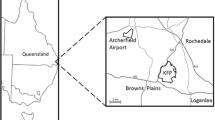Summary
The general weather situation distinctly influences the calling behaviour of both Rana esculenta and Rana ridibunda. The weather of the previous day or two previous days decides whether the frogs call or not. Calling activity following overcast skies, rain or wind is low or non-existent. After one or two warm, sunny and not too rainy days the frogs call. Considerable factors in this are also the temperature of air and water. The lower temperature limit for calling activity lies at 12°C for the water. But the air temperature is also relevant. Sudden, relatively sharp drops in the air temperature result in the cessation of calling even where water temperature would undoubtedly allow it. When the air temperature recedes sharply to 13–15°C or in persistently cool weather the frogs crawl into the bed of the pool. Before the spawning period the frogs are more sensitive to changes in the weather than during this period itself. Rana esculenta and Rana ridibunda thus possess only a single calling period, which can be interrupted into several calling phases by exogenous factors. These calling phases are not to be equated with true endogenously controlled calling periods.
Similar content being viewed by others
References
Eibl-Eibesfeldt, J.: Ein Beitrag zur Paarungsbiologie der Erdkröte (Bufo Bufo). Behav. 2, 217–236 (1950)
Eibl-Eibesfeldt, J.: Vergleichende Verhaltensstudien an Anuren. I. Zur Paarungsbiologie des Laubfrosches Hyla arborea L. Z. Tierpsychol. 9, 338 (1953)
Eibl-Eibesfeldt, J.: Vergleichende Verhaltensstudien an Anuren. II. Zur Paarungsbiologie der Gattungen Bufo, Hyla, Rana, Pelobates. Zool. Anz. 19, 315–323 (1956)
Flindt, R., Hemmer, H.: Parameter für das Einsetzen der Paarungsrufe bei Bufo calamita Laur. und Bufo viridis Laur. Salamandra 3, 98–100 (1967)
Forselius, S.: Distribution and reproductive behavior of Rana esculenta L. in the coastal area of N. Uppland, C. Sweden. Zool. Bidr. Uppsala 35, 517–528 (1963)
Heinzmann, U.: Variabilität des Paarungsrufes der Geburtshelferkröte, Alytes o. obstetricans. Experientia (Basel) 24, 293 (1968)
Heinzmann, U.: Untersuchungen zur Bioakustik und Ökologie der Geburtshelferkröte, Alytes o. obstetricans (Laur.). Oecologia (Berl.) 5, 19–53 (1970)
Heusser, H.: Wandertrieb und populationsspezifische Sollzeit der Laichwanderung bei der Erdkröte. Rev. suisse Zool. 75, 1005–1012 (1968)
Knoepffler, L.-Ph.: Additifs à la faune herpétologique des îles d'Hyères. Vie et Milieu 11 (2) 331 (1960)
Knoepffler, L.-Ph.: Contribution à l'étude du genre Discoglossus (Amphibiens, Anoures). Thèses présentées à la Faculté de Sciences de l'Université de Paris, Ser. A, No 932, 1–96 (1961)
Lörcher, K.: Einfluß der Wassertemperatur auf die Paarungsrufe der Unken. Naturwissenschaften 21, 559–560 (1966)
Lörcher, L.: Vergleichende bioakustische Untersuchungen an der Rot- und Gelbbauchunke, Bombina bombina (L.) und Bombina v. variegata (L.). Oecologia (Berl.) 3, 84–124 (1969)
Lörcher, K., Schneider, H.: Vergleichende bio-akustische Untersuchungen an der Kreuzkröte, Bufo calamita (Laur.), und der Wechselkröte, Bufo v. viridis (Laur.). Z. Tierpsychol. 32, 506–521 (1973)
Obert, H.-J.: Morphologie von Hoden und Hypophyse der Erdkröte (Bufo b. bufo) während der Fortpflanzungsperiode. Zool. Jb. Physiol. 76, 185–197 (1971)
Obert, H.-J.: Untersuchungen zur hormonalen Steuerung der Ruf- und Paarungsaktivität bei der Rot- und Gelbbauchunke, Bombina bombina und Bombina v. variegata. Zool. Jb. Physiol. 77, 166–168 (1973)
Obert, H.-J.: Untersuchungen zur hormonalen Steuerung der Rufaktivität von Fröschen und Kröten der Familien Ranidae, Discolossidae, Hylidae und Bufonidae. Zool. Jb. 78, 219–241 (1974)
Obert, H.-J.: Investigations into the significance of testicles and interrenal gland in the hormonal control of mating call activity in the common frog Rana temporaria (L.). Zool. Jb. Physiol. (1975, in press)
Savage, R. M.: The breeding behavior of the common frog Rana temporaria. Proc. Zool. Soc. London, p. 55–70 (1934)
Schneider, H.: Bio-Akustik der Froschlurche. Stuttg. Beitr. Naturk. 152, 1–16 (1966a)
Schneider, H.: Die Paarungsrufe einheimischer Froschlurche. Z. Morph. Ökol. Tiere 57, 119–136 (1966b)
Schneider, H.: Rufe und Rufverhalten des Laubfrosches Hyla arborea arborea (L.). Z. vergl. Physiol. 57, 174–189 (1967)
Schneider, H.: Bioakustische Untersuchungen am Mittelmeerlaubfrosch. Z. vergl. Physiol. 61, 369–385 (1968)
Schneider, H.: Die Steuerung des täglichen Rufbeginns beim Laubfrosch Hyla arborea arborea (L.). Oecologia (Berl.) 8, 310–320 (1971)
Schneider, H.: Structure of the mating calls and relationships of the European tree frogs (Hylidae, Anura). Oecologia (Berl.) 14, 99–100 (1974)
Schneider, H., Eichelberg, H.: The mating call of hybrids of the fire-bellied and yellow-bellied toad (Bombina bombina (L.), Bombina v. variegata (L.), Discoglossidae, Anura). Oecologia (Berl.) 16, 61–71 (1974)
Van Gelder, J. J., Hoedemaekers, H. C. M.: Sound activity and migration during the breeding period of Rana temporaria L., R. arvalis Nilsson, Pelobates fuscus Laur. and Rana esculenta L. J. Anim. Ecol. 40, 559–568 (1971)
Wahl, M.: Untersuchungen zur Bio-Akustik des Wasserforsches Rana esculenta (L.). Oecologia (Berl.) 3, 14–55 (1969)
Weber, E.: Vergleichende Untersuchungen zur Bioakustik von Discoglossus pictus, Otth 1837, und Discoglossus sardus, Tschudi 1837 (Discoglossidae, Anura). Zool. Jb. Physiol. 78, 40–84 (1974)
Weber, E., Schneider, H.: Artspezifische Paarungsrufe bei Discoglossus pictus, Otth 1837, und Discoglossus sardus, Tschudi 1837 (Discoglossidae, Anura). Z. Naturforsch. 26b, H. 10, 1055–1057 (1971)
Author information
Authors and Affiliations
Rights and permissions
About this article
Cite this article
Obert, HJ. The dependence of calling activity in Rana esculenta Linné 1758 and Rana ridibunda Pallas 1771 upon exogenous factors (Ranidae, Anura). Oecologia 18, 317–328 (1975). https://doi.org/10.1007/BF00345852
Received:
Issue Date:
DOI: https://doi.org/10.1007/BF00345852




